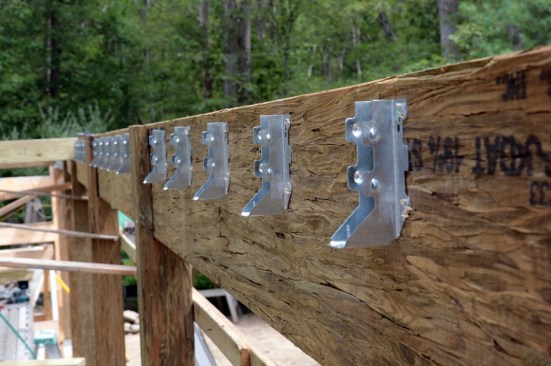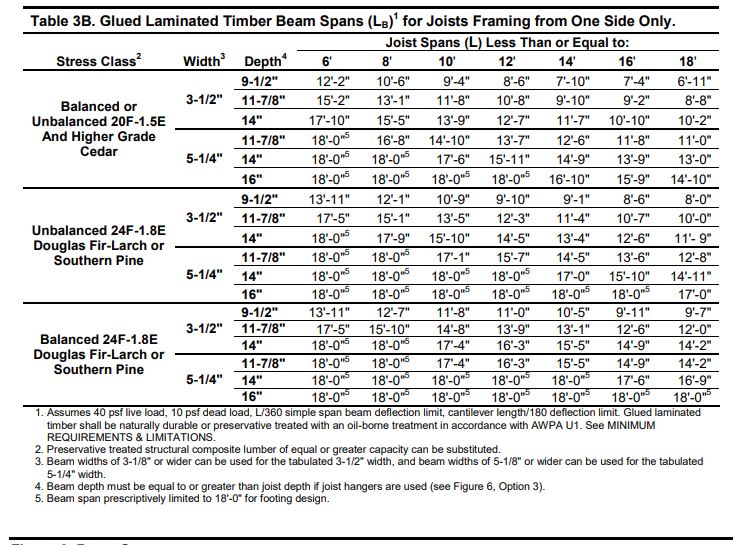Q. In my experience framing houses, there’s a lot to like about engineered lumber – it’s typically stronger, stiffer, and available in larger sizes than sawn lumber, allowing for longer spans and fewer support columns underneath. In addition, manufacturers often provide warranties, which typically are not available for dimensional lumber. So why isn’t engineered lumber used for deck framing very often?
A. Jim Anderson, a product engineer with Weyerhaeuser, responds: Engineered wood products (EWP) are sometimes specified for outdoor deck applications for all the reasons you mention. However, not all engineered wood products are suitable for outdoor exposure or available with preservative-treated or naturally durable wood, as required by the IRC. In addition, untreated EWP should not be used for deck framing.
Table 3B in the American Wood Council’s DCA 6 Prescriptive Residential Wood Deck Construction Guide provides allowable spans for glulam beams that are either preservative-treated or made of a naturally durable wood species, such as cedar. However, except for a footnote to Table 3B that allows treated structural composite lumber (SCL) of equal or greater capacity to be substituted for the glulam beams in the table, DCA 6 does not address the use of SCL members–such as laminated veneer lumber (LVL), parallel strand lumber (PSL), laminated strand lumber (LSL), and oriented strand lumber (OSL)–in decks.
Current choices for preservative-treated engineered wood products are limited, because not all engineered wood products are suitable for preservative treatment, and not all EWP manufacturers offer preservative-treated products. For example, preservative-treated LVLs are currently not offered for outdoor use, since some wood species used in LVL production don’t readily absorb the chemicals used in the preservative treatment process, and because of other factors, such as continuous glue lines between the veneers. And while LSLs have been successfully treated for use as sill plates by integrating treatments during the manufacturing process, these treatments and products are not suitable for AWPA use categories UC3B (the minimum requirement for outdoor use) or UC4A (the minimum requirement for wood members in ground-contact or similar applications). It is worth mentioning that many of the reasons why SCL products cannot be treated also apply to engineered wood I-joists.
Specifying treatment for a particular engineered wood product without involvement of the EWP manufacturer is not advised, since doing so may not result in a favorable outcome and will typically invalidate any warranties. When an engineered product is approved for exterior use, the manufacturer typically provides appropriate design values to account for the effects of treatment and wet use conditions. This information is generally not available for products treated without approval of the EWP manufacturer. If the EWP manufacturer doesn’t provide literature supporting the treated product, it is probably not approved. When purchasing any preservative-treated EWP product, make sure that the use category meets the application, that the product is approved and supported by the EWP manufacturer, and that the product has proper third-party certification.

Unlike other types of structural composite lumber, parallel strand lumber (PSL) can be preservative-treated to meet AWPA UC3B and UC4A standards, making it an option for deck framing.
Like PT dimension lumber, EWP members that are treated for UC3B should not be used in ground contact or in locations where they are critical to the structure and difficult to replace. Products treated for UC4A are generally suitable for use in deck substructures and some ground contact applications. Consider specifying use category UC4B to provide additional protection for columns. Examples of engineered wood products suitable for outdoor use that follow AWPA provisions are Weyerhaeuser’s Parallam Plus PSL beams, which are treated for use-category UC4A (Ground Contact-Low potential for decay,) and Parallam Plus PSL columns, which are treated for use-category UC4B (Ground Contact/Salt water splash-high potential for decay.
